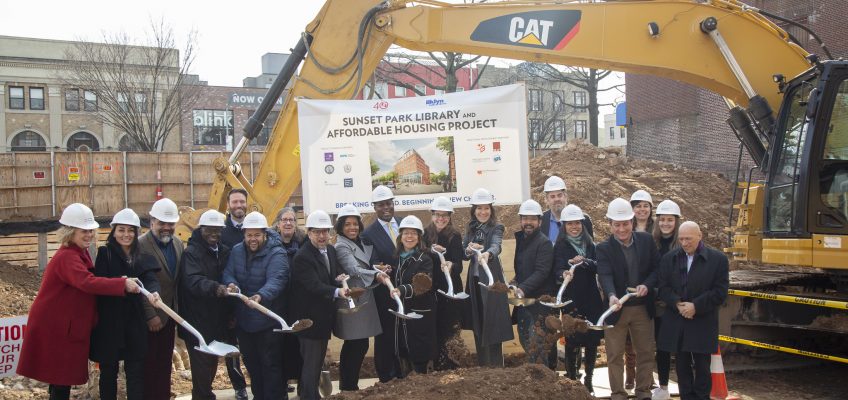“Nonprofit developers, by virtue of their governance and ownership, are the only segment of the affordable housing sector that’s required to reinvest their financial benefits of development back into their neighborhoods and people they serve.”
The groundbreaking for a city-financed affordable housing project in Sunset Park, Brooklyn in 2019. (John McCarten/NYC Council)
New York City’s “City of Yes” and “City for All” initiatives and the state’s plans for a $1.5 billion investment to expand housing are welcome steps towards addressing the most severe housing crisis we have seen in decades. Coupled with proposals being considered by two City Charter Revision Commissions, these plans, investments and proposals promise to increase housing supply overall.
But there is much more we should be doing to ensure that the public investments we make in the service of increasing housing supply are also sound investments in our communities. At a time when the current administration in Washington is committed to the retreat of government, it’s more important than ever to make sure that New York City’s housing investments support the city’s civic infrastructure and advance equity and inclusion.
To achieve the city and state’s goals, significant public investments will need to be made, and the public will need to rely on an array of developers to get this housing built. We ought to be mindful that not every dollar of public investment has the same public benefit. Specifically, we should recognize that nonprofit developers, by virtue of their governance and ownership, are the only segment of the affordable housing sector that’s required to reinvest their financial benefits of development back into their neighborhoods and people they serve.
The public-private model of housing development was born a generation ago, in the face of wavering commitments from the public sector to fully fund the cost of building and operating affordable housing. At that time, we fundamentally shifted our housing policy. Rather than public housing agencies using federal funds to build, own, and operate public housing, we outsourced significant portions of this process in favor of privately owned affordable housing.
Today the public sector sets policy priorities and then makes available the public subsidies and incentives that private developers compete for. Broadly speaking, the public sector finances and regulates, and the private sector builds, owns and operates.
In New York City, where this new public-private paradigm began, mission-oriented nonprofits were the first private movers. When the Koch Administration in the early 1980s began experimenting with this approach, the city was in crisis. Neighborhoods like the South Bronx and Central Brooklyn were being abandoned, and the city became a major landowner because of tax foreclosures.
In partnership with the city, local nonprofits bought abandoned properties from the city for a dollar, and then rebuilt and renovated them into affordable housing, bringing neighborhoods back to life. This proof of concept was encouraged and replicated nationwide, buoyed by the invention of the federal Low Income Housing Tax Credit program in 1986 and other financial tools that accelerated resources available for this type of public-private partnership model of housing development.
While nonprofits piloted this approach, almost immediately for-profit developers entered the field. They recognized that companies specializing in affordable housing could make a good business out of it. That was by design. To incentivize a broader range of development partners to enter the field and address the need at scale, our policies made it profitable for them to do so.
It took patience and nerve to navigate the public processes and secure the necessary incentives, but those that could finance and manage the construction process built a real estate asset with limited market risk. Particularly in high-cost markets like New York City, demand for affordable housing outstrips supply by thousands for each unit brought to market.
Now that we are a generation into this public-private paradigm, we can begin to see how the paths diverged between for-profit companies and nonprofits. Private developers took the financial upside and often reinvested in their businesses, growing their balance sheets and taking on larger projects. Their enterprises took on equity investors to grow their companies. And many of the early vintage private affordable housing developers cashed out of their companies and became wealthy themselves.
Nonprofits, however, took a different path. Their organizations were never owned by their principals but governed by volunteer boards. They didn’t take on equity investors. Profits at the enterprise level may have been partially invested back into the enterprises, but more often they were used to subsidize the nonprofit’s other mission or programmatic work, often within the just-completed housing development projects themselves.
Take the example of the Brooklyn-based Fifth Avenue Committee (FAC), where the authors are executive director (Ms. de la Uz) and board member (Mr. Marks). The organization began in the 1970s as a coalition of local neighbors, merchants, and block associations to address abandonment in Brooklyn’s lower Park Slope neighborhood, which had previously been redlined. Encouraged by the city under the Koch Administration, FAC soon moved into real estate development, and by the end of the 1980s, the organization owned and renovated just over 400 apartments for low- and moderate-income Brooklynites.
This year the organization celebrates its 47th anniversary, and its real estate activities have fueled not just its affordable housing pipeline (now over 2,000 homes) but its organizational growth as well. Between FAC and its affiliates, their $20 million annual budgets support over 7,000 low-and moderate-income New Yorkers annually through programs in adult education, workforce development, tenant organizing and eviction prevention, financial coaching, community health worker services, and first homebuyer assistance, to name just a few.
FAC has also become a major voice shaping a more inclusive development and planning agenda for rapidly changing neighborhoods like Gowanus. Its advocacy has resulted in tangible benefits for low- and moderate-income people: 35 percent of the 8,500 units of housing being built in Gowanus as part of the 2021 neighborhood rezoning will be permanently affordable and set aside for low- and moderate-income residents, and as part of its negotiation with the city, FAC and its coalition members secured a commitment of $200 million in much-needed capital upgrades to local public housing.
The scale and breadth of this work cannot be separated from its real estate activities. Although FAC has secured significant city and state contract funding and private grants to support its programs, generally one-third to half of its revenues in a given year come from earned income, and developer fees are a sizable portion of that. In short, its ability to deliver affordable housing has subsidized its community work. In the last three years alone, FAC has reinvested nearly $3 million of its earned income directly into programs serving low- and moderate-income New Yorkers.
But for all the resources FAC has plowed back into its community in the form of services and programs, it now operates at a disadvantage when competing for public subsidies against private developers. While nonprofit organizations like FAC used the resources it earned from projects to build up neighborhoods and support residents, private developers used their revenue to build up their businesses and attract equity investors.
This puts the private developers at an advantage for securing public subsidies because a key criterion for winning development contracts is the financial capacity of development entities. As the city and state focus on rapidly increasing housing supply, there’s a risk that we will miss an opportunity to build housing that builds neighborhoods, invests in residents, and advances equity at the same time, by prioritizing for-profit development companies that can build at scale.
To make sure that we don’t miss this opportunity to build neighborhoods, not just buildings, the public sector should weigh investments in nonprofits differently than investments in for-profits. Consideration should be given to the multiplier effects that investing in nonprofits brings to surrounding communities, the lives touched and improved beyond the residents of the new housing.
A more focused understanding of mission investment could focus not just on nonprofit developers, but community land trusts, limited equity co-ops, and other forms of mission-ownership that will keep public investment invested in the civic sector for future generations, not just the current one.
There’s an important role for philanthropy as well. Private foundations, corporate foundations, and individuals should consider building the financial capacity of nonprofits, so they have the capacity and infrastructure to build housing at scale.
What we’re calling for is not simply operating grants but investments in nonprofits at the enterprise level. This funding would help nonprofits build their financial strength, empowering them to develop even more ambitious affordable housing projects that include essential resources for the people and communities in which they are built.
Michelle de la Uz is executive director of Fifth Avenue Committee, a Brooklyn-based community development organization. Sam Marks is the chief executive officer of FJC – A Foundation of Philanthropic Funds, and serves on the Board of Directors of Fifth Avenue Committee.
The post Opinion: Why NYC Should Fund The Developers Who Stay Invested appeared first on City Limits.




